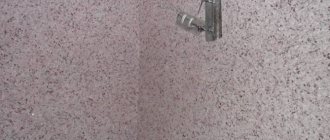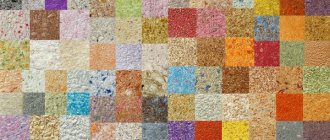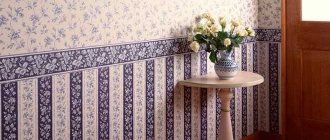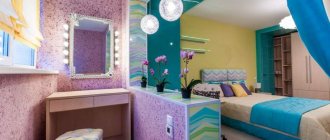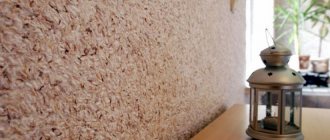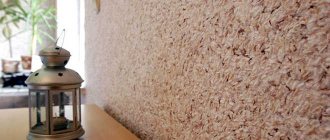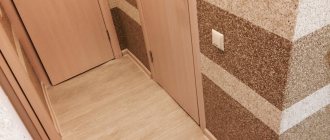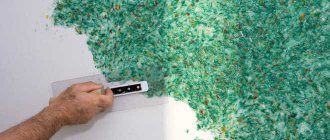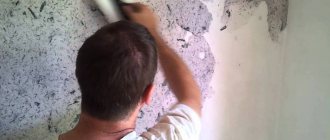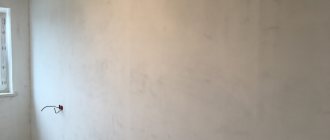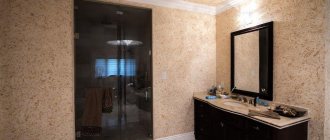The modern building materials market is filled with a variety of different finishing products. The desire to change the interior and refresh the appearance of the home poses a choice: What is the best building material? What is the most practical and quick way to deal with future repairs? Saving time and money are important aspects of determining choice for many.
One of the modern options for performing repairs is the use of decorative textured plaster or liquid wallpaper. What is cheaper, what is better and what is the difference between them? Let's analyze it by studying the properties and practical characteristics.
Both types have their advantages and some disadvantages.
Venetian decorative plaster in the interior
Silk liquid wallpaper in the interior
Each individual room requires certain operational properties, be it a kitchen, with an aggressive atmosphere, or a children's room, where the softness and hypoallergenicity of the coating must be taken into account. What attracts these representatives of finishing materials, enjoying such wide popularity? Let's make a comparison, familiarizing ourselves in detail with the types and technical characteristics.
Which is easier to apply?
The technology for applying each type of decorative plaster has its own characteristics, but in general the process can be described by the following steps:
- the surface of the wall is cleaned of old finishing material and repaired, then primed and plastered, after which it is primed again;
- the working mixture is prepared in accordance with the instructions printed on the packaging;
- the composition is applied in an even layer over the wall;
- after the mixture has set, an embossed surface is formed using relief rollers;
- after the shine disappears (after 20 minutes), the surface is smoothed in order to remove the sharp edges of the relief;
- After the plaster has completely dried, it is sanded with fine-grained sandpaper.
The process of applying liquid wallpaper is simpler:
- old wall decoration (paint, wallpaper) is removed, after which cracks and chips are repaired;
- the surface is primed with the mixture selected for application;
- the composition is prepared in accordance with the instructions printed on the packaging;
- The mixture is applied to the wall with a spatula;
- after complete drying, the wall surface is painted (no operation required for painted wallpaper).
From a comparison of technologies, it is clear that plastering work is more labor-intensive, while liquid wallpaper can be applied independently.
Reviews
Both building materials have earned positive reviews. Master finishers, comparing the complexity of the work carried out, single out decorative plaster as a difficult work to complete. Wallpaper also requires skill, but is easier to apply.
- Wallpaper. During its existence, it has also received negative comments related to poorly performed work. Errors can lead to inhomogeneity of color, and the expected brightness results in dullness. Unevenness of the layer due to a poorly prepared uneven wall and incorrect use of the tool. There are cases of early abrasion of the layer and the appearance of dirt, grease stains and other consequences of wear, which is the result of an incorrectly calculated area of application. A spectacularly advertised product does not always give the promised result, and at an expensive price.
- Plaster. According to reviews, it has more fans, but many are not satisfied with the pricing policy, both of the product itself and of hired labor. You can plaster it yourself, but it’s difficult with decorative elements, and it’s not advisable to take risks. Budget types of plaster are also offered, but they are inferior aesthetically when compared with wallpaper. Her appearance especially stands out; the incomparable attractiveness of some styles will not leave anyone indifferent.
Differences between liquid wallpaper and decorative plaster in terms of maintainability
- the damaged area of liquid wallpaper is moistened with water, cleaned off with a spatula and a new portion of liquid wallpaper is applied;
- Decorative plaster has great strength, and repairing damaged areas seems to be a rather labor-intensive process with several technological operations.
Decorative plaster carries an element of prestige for the owner and emphasizes his status in society; liquid wallpaper is more democratic in this regard. Repair using liquid wallpaper takes less time than coating with decorative plasters.
The price factor is also important; liquid wallpaper will end up being cheaper than decorative plaster (in addition to plaster, additional materials, paints, primers, etc. are required).
Finishing with liquid wallpaper can be done more often than with decorative plaster. Finishing with decorative plasters provides a long service life.
Comparison of characteristics
To understand the difference between liquid wallpaper and decorative plaster, you should compare their technical characteristics according to certain parameters.
The main difference between plaster and wallpaper is the presence of quartz sand in the plaster mixture, while the base of the wallpaper is cellulose. Both materials have the following similar characteristics:
- They have good adhesion to all types of surfaces (concrete, drywall, brick, wood).
- Both materials mask defects on the base in the form of small cracks, cavities and chips.
- They are effective sound insulators.
- With their help you can create colored, textured patterns.
- They are vapor permeable.
- They are insulation.
- They have a long service life.
- The final coating is formed without joints.
- Environmentally friendly.
In many respects, there is a similarity between the finishing options discussed in the article. The difference between these coatings lies in the following points:
- The surface of decorative plaster is much stronger and better resistant to mechanical stress than the surface of its cellulose counterpart.
- Plaster can be cared for using a vacuum cleaner or a damp cloth, while wallpaper can only be vacuumed or dusted off with a dry cloth.
- Plastered surfaces cope well with high humidity, so this finish is recommended for bathrooms and kitchens. The cellulose base loses its properties when exposed to vapor and moisture, so this coating is recommended for use in rooms and hallways.
- Plaster can be applied to external walls, unlike wallpaper.
- The plastered surface does not fade in the sun and retains its original shade throughout its entire service life; for cellulose-based materials, the tone of the coating changes over time.
- The cost of the work and the plaster itself, in comparison with the installation of wallpaper, is much higher.
- Wallpaper has the ability to simply restore a damaged surface; for plaster, such work will be more complex and expensive.
- When using plaster in new wooden houses, it should be taken into account that shrinkage of the crowns can lead to cracking of the finished surface; liquid wallpaper is not afraid of shrinkage.
- If it is necessary to dismantle the coating, liquid wallpaper can be easily removed, whereas plaster will have to be tinkered with.
- A beginner can handle surface treatment with wallpaper; to apply plaster, you will have to hire a specialist.
- The surface treated with wallpaper resembles silk, the texture of the plaster is much rougher.
General advantages and disadvantages
If you turn to encyclopedic reference books, you can find the following characteristic of decorative plaster - this is the finishing layer of a hardened solution of alabaster, lime or gypsum, applied to the walls and ceiling to give the surface an aesthetic appearance.
Liquid wallpaper is, in principle, the same decorative plaster, i.e. a hardened layer of mixture applied to walls for finishing. The following facts indicate a confusion of concepts: in the technical specifications liquid wallpaper is designated by the term “silk plaster,” and Wikipedia classifies silk plaster as one of the types of decorative. There is another term that causes confusion - “Danish decorative plaster”, which is actually liquid wallpaper.
In order not to get confused, you need to understand the difference between these finishing materials. Their main and only difference is that decorative plaster contains quartz sand, while liquid wallpaper does not contain it - it is replaced by cellulose.
Another surprising thing is that these materials have almost identical advantages. If we talk about the advantages, they are:
- applied to walls made of any material: gypsum plasterboard, brick, stone, concrete, wood;
- hide imperfections in the surface of a wall or ceiling: cracks, cracks, sinkholes, chips;
- allow you to create various patterns and full-fledged drawings, in color;
- have good sound insulation properties;
- regulate the microclimate in the room thanks to the ability to “breathe”;
- good insulation;
- have a long service life;
- belong to an environmentally friendly finishing material - the components of the mixture are not hypoallergenic;
- have no seams or joints - a solid surface is more aesthetically pleasing and durable;
- do not have waste in the form of paper scraps, adhesive residues, etc.
At the same time, there is still a difference between decorative plaster and liquid wallpaper.
Decorative plaster
This plaster has additional advantages:
- high surface strength - difficult to damage mechanically;
- easy care - the wall is cleaned with a wet cloth or vacuum cleaner;
- is not afraid of water, so you can plaster rooms with high humidity (bathroom, kitchen);
- also used for outdoor work - withstands temperature changes from -55 to +60 degrees Celsius;
- has enormous potential for implementing various design ideas;
- Retains rich, bright color throughout its service life.
The disadvantages include:
- high cost of finishing;
- difficulty in restoring damaged areas (in most cases restoration is impossible);
- cannot be applied to walls in houses that shrink - they will crack;
- the labor-intensive process of removing from the walls during replacement;
- professionals are required to carry out the work - a complex and labor-intensive plastering technology.
Liquid wallpaper
Among the advantages inherent only in liquid wallpaper, the following stand out:
- elasticity - withstands any shrinkage and does not crack;
- do not require experience or training - any beginner can do the job;
- budget cost of finishing;
- ease of removal when switching to another type of finish;
- can be restored if damaged during operation;
- pleasant appearance and texture - soft to the touch, reminiscent of silk.
For information: for repairs, you can use frozen mixtures left over after finishing the finishing work.
Minuses:
- are afraid of moisture - can only be used in living rooms and hallways;
- cannot be used for façade finishing;
- limited color and texture;
- They fade quickly when exposed to ultraviolet rays.
Economic component when choosing
The cheapest option is, of course, paper wallpaper, but you should understand the following: in order for paper wallpaper to look beautiful, you need to level the walls by applying plaster to them. Therefore, the price of the issue increases.
Non-woven and vinyl wallpapers are more expensive, but a significant part of the wall defects under them will be invisible, so you may save on plaster.
Liquid wallpaper is quite capricious, so you need to properly prepare the walls for it and give it a white color. The cost of liquid wallpaper is not small.
Good decorative plaster is more expensive than most wallpaper, but for this money you get durable, practically indestructible walls. However, some expensive wallpaper will cost you more than plaster. Work on applying decorative plaster also costs more than when wallpapering.
Conclusions on the topic
Thus, we told you that decorative plaster or liquid wallpaper is better. Of course, we have not come to a clear answer. Each of you will answer this question in your own way, having familiarized yourself with the disadvantages and advantages of this or that finishing material. Depending on the type of room, your budget, goals and objectives, you will choose your material.
You can also read about other finishing materials on our website, just use the search and find the information that will be of interest to you.
Liquid wallpaper
- Liquid wallpaper is a fairly new material that not everyone knows yet. Often, liquid wallpaper is rather the younger brother of rolled wallpaper and decorative plaster at the same time. If you cannot choose between roll wallpaper and decorative plaster, then simply choose liquid wallpaper.
- Firstly, liquid wallpaper is sold either in the form of a solution ready to be applied with a spatula, or in the form of powder bags that need to be diluted with water and stirred.
- Liquid wallpaper has the advantage of being warm, unlike decorative plaster. No matter what kind of plaster you apply and what effect you imitate, it will be a continuation of stone walls and, in addition, solid walls.
- Liquid wallpaper is warm and soft, so it gives a special coziness. If this is not so important for hot countries, then for our hemisphere, where rain and wind dominate to a greater extent, this is an important point.
- We would recommend using liquid wallpaper in bedrooms, because this is where comfort and coziness are so important.
- It is worth saying a little about prices. Liquid wallpaper is never cheap, so there is definitely a minus here, but if you compare it with decorative plaster, you cannot say that it (plaster) will be cheaper, rather the opposite.
How to make the right choice
Having understood how these materials differ from each other, you can draw a conclusion for yourself which composition to choose in a particular situation. The decision is made based on preferences, requirements and capabilities. Those who require a practical, durable and high-quality coating that will not have to be replaced in the next 10 years, and whose budget is not too limited, should give preference to decorative plaster. It can be used not only in rooms, but also in bathrooms. For people who love change, have children or animals, and are looking for an inexpensive but aesthetic material for decorating walls in a living space, liquid wallpaper is more suitable: they can be repainted if you want to update the interior, and restored if they are damaged.
Which is easier to apply?
To obtain a high-quality surface using decorative plaster, you will have to invite a specialist, since this work is beyond the power of beginners. The plastering process consists of several points:
- dismantling the old coating and priming the base;
- preparation of solution;
- uniform distribution of the mixture over the surface;
- formation of structure using relief rollers;
- smoothing the surface with a grater;
- grinding;
- applying dye.
Liquid wallpaper, from the point of view of work, is simpler and more profitable; the process can be mastered even by a novice finisher. The following actions must be taken:
- dismantle the old coating and eliminate major defects;
- prime the surface;
- prepare the mixture;
- apply the prepared solution to the base using a spatula;
- After drying, painting is done.
Main differences
Many people believe that decorative plaster and liquid wallpaper are the same thing. However, it is not. Although both of these materials are classified as finishing coatings, they differ in several respects. The most important difference is the composition. Liquid wallpaper is made from cellulose and fabric fibers, and plaster is made from stone chips. In terms of wear resistance, practicality and ease of maintenance, decorative plaster is superior to wallpaper. The latter are easy to damage and are not moisture resistant.
Types of liquid wallpaper
Liquid wallpaper is classified according to the filler material. The appearance and strength characteristics depend on this.
The list of types is not as long as that of decorative plasters:
- cellulose;
- cotton;
- silk;
- combined.
Survey. What type of liquid wallpaper do you prefer?
Cellulose 30.61%
Cotton 12.24%
Silk 32.65%
Combined 24.49%
Voted: 49
In addition to differences in material, liquid wallpaper differs in its application. Basically, they are ready-made finishing material. But they can also be a substrate that creates the texture of the surface being finished.
Based on the surface texture they are distinguished:
- smooth;
- embossed liquid wallpaper.
Cotton
The raw materials for the filler are 100% natural cotton fibers. Its share in the mass is 98%, the rest consists of additives of cellulose and textile fibers, mica, which adds shine. The drying time for coatings with a thickness of 1-10 mm is 48 hours. The mass with cotton fibers creates a rough coating and a velvety matte sheen.
cotton
Manufacturers have taken care of the richness of the color palette and offer about 240 shades. Among them you can always find what you want, but if a more exact color match is needed, you can mix mixtures of the desired tones, as artists do. You can also use colors.
Cotton blends are most often used to decorate bedrooms, as well as rooms for young family members, and office interiors. The choice is based on increased safety and non-toxicity. In addition, children's rooms and offices like to be transformed more often, so the fact that the cotton composition is not as durable as silk does not play a special role.
Silk
The inclusion of silk fibers gives the coating a silky shine. The coatings have the effect of expensive fabric shimmering in the light. In addition to natural silk fibers, the mixture contains artificial silk fibers, decorative additives and colored quartz.
silk
Such compositions look richer, and their price is higher, although the latter is relative. They are more durable than silk plaster of other categories. The use of such finishing material is universal. It is most suitable for luxury apartments, commercial properties and administrative premises. In terms of sophistication it can be as good as Venetian plaster. Pairs perfectly with cork, natural stone, and snow-white stucco.
Silk coating will last up to 10 years without losing its originality and freshness of colors. It absorbs almost no odors. The coating firmly “clings” to the base without swelling or delamination. When protected with acrylic varnish, it can be used in damp rooms.
Pulp
The filler material is wood waste. Another name is paper. This is the cheapest material. Most often used for cold, non-residential premises.
celluloseCellulose mixtures lend themselves well to additional coloring and are easily restored. Least durable. The cost is almost the same as that of cotton ones.
Combined
Blends with silk and cellulose fibers or silk-cotton compositions have their own charm.
combined
Ugly and embossed liquid wallpaper
Almost all of the wallpapers listed above can be made with different surface textures.
Embossed wallpaper will help hide minor imperfections in the base and, accordingly, are less demanding in its preparation. Such wallpaper will help you bring to life the most daring design solutions. With all this, the terrain (as always) will accumulate more dust.
Smooth wallpaper, in turn, is more familiar to the average person, and is also more often distinguished by a variety of design options.
Paintable liquid wallpaper
On the shelves we can find the so-called “base”. This is an unpainted dry mass, which is also called unfinished wallpaper. You can add not only dye to this mixture, but also glitter and other decorative additives (optional).
Painting the walls
Tips for choosing paint for kitchen walls:
- Choose an acrylic-based composition. This paint is medium thick, easy to apply and dries quickly. Forms a glossy finish that is easy to clean.
- The paint chosen for the kitchen must withstand temperature changes and exposure to steam well. If the walls have defects, choose matte compounds.
- The color and structure of the paint should match the interior of the kitchen.
Advantages of paint:
- easy to apply;
- you can mix colors;
- You can cover the walls with a new layer.
There is only one minus - if you do not prepare a rough coating for the walls, after painting all the defects will be visible on them.
Differences between liquid wallpaper and decorative plaster in terms of maintainability
- the damaged area of liquid wallpaper is moistened with water, cleaned off with a spatula and a new portion of liquid wallpaper is applied;
- Decorative plaster has great strength, and repairing damaged areas seems to be a rather labor-intensive process with several technological operations.
Decorative plaster carries an element of prestige for the owner and emphasizes his status in society; liquid wallpaper is more democratic in this regard. Repair using liquid wallpaper takes less time than coating with decorative plasters.
The price factor is also important; liquid wallpaper will end up being cheaper than decorative plaster (in addition to plaster, additional materials, paints, primers, etc. are required).
Finishing with liquid wallpaper can be done more often than with decorative plaster. Finishing with decorative plasters provides a long service life.
What is the fundamental difference between these two options?
When the question arises: “which finish is better - wallpaper or decorative plaster,” we should not forget that liquid wallpaper itself is just a type of plaster. In other words, we are talking about comparing the particular with the general, and if liquid wallpaper has fairly standard characteristics, then plaster offers a slightly wider selection of qualities. More correctly, this question would be formulated as a choice between liquid wallpaper and other types of decorative plaster.
For what qualities is liquid wallpaper chosen?
Liquid wallpaper has a number of advantages - enough to give preference to them. Judge for yourself:
- The relatively low cost allows literally anyone to purchase liquid wallpaper - they are much cheaper than competing decorative plaster, even in their elite version.
- In case of any damage to the coating, there is no need to grab your head, because the problem can be solved extremely simply. It is enough to thoroughly wet the material near the damaged area - it will turn into a substance as soft as plasticine, then carefully seal the defect with your fingers. If the damage is significant, you can completely replace the damaged fragment - to do this, part of the mixture prepared during finishing must be kept frozen.
Damaged liquid wallpaper finish can be easily repaired
- If the owner of the premises decides that it is time for a new finish, he will not have any problems with removing liquid wallpaper.
- Applying liquid wallpaper does not require any special skills or long training - you only need patience and accuracy. However, any sloppiness in this case can be corrected quite easily.
Thus, liquid wallpaper is definitely better in terms of the financial side of the issue - if decorative plaster still turns out to be cheaper, then the quality of such finishing will be quite low. Wallpaper is also more relevant in a situation where there are four-legged pets in the house, since they are extremely easy to repair, and are also the best solution if the repairs for some reason are not done for long.
Another thing is that liquid wallpaper is completely inapplicable in the kitchen or bathroom, as well as in walk-through rooms, and they do not differ in the special variety of design solutions available for choice.
Pros and cons of decorative plaster
Of course, decorative plaster also has certain characteristics that make people prefer it. The most commonly noted benefits are:
- This material provides enormous space for real creativity, offering the widest range of available colors and shades, the ability to combine them, create three-dimensional shapes, and so on.
- Decorative plaster is not afraid of water, so it can be washed without fear of repairs. If you still have concerns about ruining the finish with an incorrectly calculated amount of water, you can coat the finished surface with special protective compounds.
- Plaster is generally stronger than liquid wallpaper; mechanical damage is not so dangerous for it.
- Such repairs are definitely more durable; they are able to maintain their original appearance for decades without fading or fading.
Unlike liquid wallpaper, decorative plaster is stronger and more durable.
So, if the customer of the repair considers himself one of those people who love stability and durability in everything, including interior decoration, then it is better to choose decorative plaster, because upon completion of the work no problems are expected with it. This option will fit perfectly into any room in an apartment, house, or office. The material is designed to create the maximum aesthetic effect, allowing the owner to express himself (provided that he himself participated in the development of the repair) or simply be proud of the result.
Finishing walls with decorative plaster will cost much more than liquid wallpaper
At the same time, both application and removal of the material is considered a rather labor-intensive process, and it is not a fact that the owner will want to do all this on his own. Since application is a problem, then repairing a small area is also problematic - you can save the dry mixture, but if you don’t know how to apply it yourself, then it’s better not to try. In this context, pets or small children can pose a serious threat to the good appearance of the decorative finish. Finally, such repairs are not at all budgetary, so a certain part of the population will initially refuse such a choice.
Types of plaster
Decorative plaster can be:
- Stone. It perfectly imitates natural material. Small pebbles of different sizes can be used as filler. During the installation process, it is recommended to use different methods of applying the material to create a more natural look for the base.
- Venetian. In this case, the composition contains marble chips and flour. As a result, it is possible to obtain a coating that is practically indistinguishable from real marble with a characteristic translucent structure. However, you need to be prepared for the fact that during the work you will need to polish each layer. It is also worth noting the fragility of the finished coating. It can be damaged by one hit.
- Sgraffito. In this case, textured patterns or panels are created on the surface. However, to create such a unique coating you need to have the appropriate skills and be prepared for lengthy work. As a rule, such solutions are more often used for restaurants, hotels, and cafes.
- Color. In this case, colors, dyes and various decorative additives are used.
- Terrazitova. Such mixtures contain sand, quartz and marble particles. The basis of the composition is exclusively mineral. Laying is done in layers. This solution is most often used for facade finishing.
- Silk. In this case, natural or synthetic fibers can also be used. Also, as in the case of wallpaper, the composition may include glitter, which will give an additional silver or golden tint.
Decorative plaster can be silicate, acrylic, silicone and mineral. The compositions can be used for both interior and facade decoration of buildings.
Pros and cons of plaster
Among the main advantages are:
- The ability to create unique shapes and wall designs.
- Easy to care for.
- Increased strength (with the exception of a few varieties) to mechanical damage.
- Durability.
Among the disadvantages, installation can be distinguished. If any section of such plaster is damaged, it will be very difficult to restore it yourself. Problems will also arise during the process of dismantling the coating.
It is also worth paying attention to the high price of such mixtures. A 25-kilogram bag of the mixture will cost 550-3600 rubles. Accordingly, finishing 1 m2 will cost 140-2400 rubles. This scatter is due to the many types of compositions.
Application method
Most often, you need to hire a finisher for the job. The main stages of applying plaster are as follows:
- The old coating is removed from the wall and a primer is applied.
- A mixture is prepared (some formulations are sold ready-made, while others require dilution with water).
- The composition is applied to the wall using the method required for the specific coating.
- Using various tools, the necessary relief is created. This is usually done when the composition has already “set” a little.
- 20 minutes after this, when the surface ceases to shine with moisture, the relief is smoothed out.
- Small defects and irregularities are smoothed out.
- The composition dries out.
After this, additional processing is carried out, for example, gilding or painting, if required.
What do they look like in the interior?
Liquid wallpaper can be applied to walls in any premises (residential and office). They are able to hide surface defects, and therefore can replace a layer of finishing plaster. The main task is to give the walls the desired appearance to create the intended interior. In an apartment, wallpaper is quite appropriate in the living room, bedroom, hallway, bathroom, kitchen and loggia. With their help, various decorative effects are provided. This can be achieved in several ways - painting in different colors, forming designs and patterns, giving a relief to the surface, applying in stripes with a change in direction. Which method to choose depends on the type of room and design style.
Look at the video, a selection of pictures of the interior of rooms with liquid wallpaper on the wall.
Colors
When finished, liquid wallpaper immediately has a certain color. In this case, the desired option is selected taking into account the overall design style. To give any shade, the appropriate pigment is added to the mixture when mixed with water. In the classic style, preference is given to light, warm tones. In modern design, color contrast is widely used, when different walls can have different shades.
Liquid wallpaper of heavenly color
Rich shade in the living room
White wallpaper is usually used for painting. After hardening, paint of the desired color is applied to them. The following colorful compositions are most suitable:
- Water-based paint. It is suitable for dry rooms and is the cheapest option. The paint is diluted with water to a convenient consistency, and the desired color is achieved by adding dye.
- Acrylic paints. This is the most common material that has sufficient moisture resistance and abrasion resistance.
- Latex paints. They are used to decorate rooms with high humidity. Wallpaper with this coating can be washed using ordinary detergents.
- Silicone paints. This is one of the most expensive options, but the coating has improved performance properties and greater durability.
Leaf IMPORTANT! Painting liquid wallpaper is carried out using a roller or spray gun. In hard-to-reach places, use a brush of different widths
Before painting, it is recommended to coat the surface with a strengthening primer, which will improve the adhesion of materials.
Drawings
One of the most effective ways to decorate walls is to apply drawings, patterns, and ornaments to the surface. In the case of liquid wallpaper, 2 methods are used: applying a pattern by painting a hardened layer (art painting) or forming a pattern with the composition of the liquid wallpaper itself using stencils.
Original drawing in the interiorWhen painting artistically, paint is applied in the following ways:
- painting with a brush;
- drawing a picture using a stencil;
- not applying the ornament using a relief roller.
The following design solutions are used in the design:
- chaotic stains or spots with contrasting highlight;
- geometrically correct arrangement of patterns, lines and small drawings;
- complex drawings, paintings.
Star IMPORTANT! In the theme, preference is given to flowers, stars, butterflies, abstract drawings, images of trees and animals, as well as famous architectural creations
In the living room
Different rooms use different approaches to decoration. The living room provides maximum comfort and solemnity. For small areas, light colors are recommended. Wallpaper with large patterns is suitable for large living rooms.
It is important to coordinate the design of walls, furniture and lighting
In the bedroom
In the bedroom, preference is often given to the fabric effect. Color contrasts are often used. Popular styles: Baroque, Renaissance.
For kitchen
For the kitchen, designs are chosen that increase appetite. Still lifes look good. It is recommended to avoid flashy patterns
Particular attention is paid to the area near the sink and desktop
It is important here to ensure maximum moisture resistance, as well as resistance to grease and aggressive substances. This area can be coated with latex-based varnish.
This area can be coated with latex-based varnish.
For children's
The absolute environmental friendliness of liquid wallpaper for walls allows it to be used in children's rooms. Here, when designing, you can apply images of animals, fairy-tale or “cartoon” characters
It is especially important to create a cheerful interior, with bright colorful areas
